|
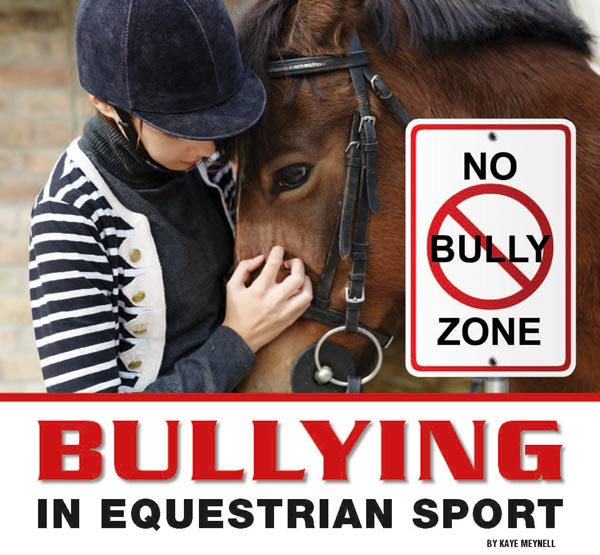
Whether physical, verbal, social or online, bullying causes real harm to those targeted and significantly affects wellbeing. It can occur anywhere - in school, on the sporting field, in the workplace or home – and in a myriad of ways. Reports of bullying in the equestrian world – both on the yard and the competition field - are becoming increasingly common, but is this truly a reflection of an industry where poor conduct is viewed as acceptable or is it the result of confusion over what constitutes bullying behaviour?
DEFINITION
The Australian Human Rights Commission defines bullying as a situation in which “people repeatedly and intentionally use words or actions against someone or a group of people to cause distress and risk to their wellbeing. These actions are usually done by people who have more influence or power over someone else, or who want to make someone else feel less powerful or helpless.” The key word here is ‘repeatedly’; a one-off incidence is unlikely to be recognised as bullying. When it comes to equestrian sport, Equestrian Australia (EA) provides good examples of relationships that involve a power disparity, these being coach/competitor, manager/competitor, employer/employee, vet/horse owner and Committee/competitor and the organisation is clear to point out that “people in such positions of power need to be particularly wary not to exploit that power.”
TYPES OF BULLYING
Before delving further into this topic, it is critical to understand exactly what behaviours constitute bullying, remembering that we are dealing with repeated incidences of these. There are three distinct, recognised categories:
Direct Bullying
Included in this type of bullying is physical violence against a person or their property, or face-to-face verbal insults, such as name-calling or homophobic, sexist or racist remarks.
Indirect Bullying
Less easy to recognise, indirect bullying tends to be conducted out of sight, often including behaviours such as excluding people from groups (social exclusion) or spreading lies or rumours. In younger people, because it is less obvious, it is often unacknowledged by adults, says The Australian Human Rights Commission. Bullying of this nature may be less direct but is just as damaging to the victim.
Cyberbullying
Considered an extension of ‘traditional’ bullying, cyberbullying takes the location of bullying behaviour away from the workplace/home/school etc., meaning those subjected to it can be targeted 24/7. The rise of social media is allowing bullies to target their victims via email, social networking sites or instant messages and at any time of day or night.
Unlike 20 years ago when somebody left the school or workplace for the day and had a period of time where they were removed from the bullying environment, now victims can be bullied almost constantly.
“It can also be anonymous, can reach a wide audience, and sent or uploaded material can be difficult to remove. Most people who cyberbully also bully off-line,” comments The Australian Human Rights Commission. EA has clear rules regarding cyberbullying, acknowledging that “new technologies and communication tools, such as smart phones and social networking websites, have greatly increased the potential for people to be bullied through unwanted and inappropriate comments.”
EA’s official stance is that frustration at an Official, Coach, sporting body or fellow athlete should never be communicated on social networking websites, but issues addressed - in a written or verbal statement or a complaint – to the relevant controlling club or sporting body.
THE BULLY AND THE VICTIM
Whilst we tend to think of children and younger people when it comes to bullying, adults suffer too, especially within the workplace. A recent report conducted by Safe Work Australia (Bullying & Harassment in Australian Workplaces: Results from the Australian Workplace Barometer Project 2014/15), found that 9.4% of workers reported being subjected to bullying in the previous 6 months, 32.6% of which were bullied at least once a week. In more than 60% of cases, the bully was identified as a supervisor. The prevalence of workplace bullying in Australia is on the increase. Of the seven types of harassment measured in this survey, the most common forms of harassment reported were being sworn at or yelled at and being humiliated in front of others.
Bullying and most forms of harassment are associated with adverse psychological health outcomes including depression and emotional exhaustion. The annual economic cost of bullying in Australia was estimated at up to $36 billion (Productivity Commission, 2010). For an older individual, it can be much harder to raise the issue of bullying especially if they fear that flagging such behaviour in a co-worker or peer will negatively affect their career.
THOSE THAT BULLY
Those that bully do so for many different reasons, however a common finding is that a person who victimises others does so in order to exert dominance and elevate their social status. They often show little remorse. Interestingly, when it comes to children at least, most bullies have almost ridiculously high levels of self-esteem, reports Stuart Wolpert from the UCLA Newsroom, on research conducted by Jaana Juvonen, a professor of developmental psychology at the university. A decade ago, when Professor Juvonen and colleagues began their research, they found it a challenge to convince their audiences that bullying was a problem. “Ten years ago — and even today in some parts of the country and in some families — there was a belief that bullying is just part of growing up … and that these experiences are even needed (by the victims) because they ‘help build character.’ We have learned that bullying can have devastating consequences - most tragically, those cases where victims of bullying have committed suicide,” she says.
Juvonen is of the belief that bullying is not a problem of specific individuals, but a collective problem and social dynamics need addressing. Her work has also highlighted that, in school-aged children at least, the role of bully and victim can be temporary social roles that can be changed, rather than permanent personality characteristics.
WHAT BULLYING IS NOT
The National Centre Against Bullying provides clarity about what bullying is not. It is not single episodes of social rejection or dislike, acts of nastiness or spite, nor is it random acts of aggression or intimidation, or mutual arguments, disagreements or fights.
Workplace bullying is defined as repeated and unreasonable behaviour directed towards a worker or a group of workers that creates a risk to health and safety. Unreasonable behaviour does not include reasonable management action, such as discussions about work performance, as long as they are taken in a reasonable way (Safe Work Australia).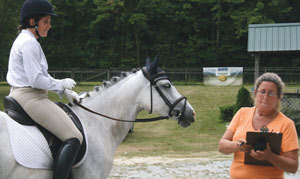
"Unfortunately, there are many instances
of bullying that are very subtle or hard to
flag to others, and this is where the equestrian industry needs to become more vigilant. Examples include situations where the same people hold multiple positions of office in equestrian organisations for long periods. ”
EQUESTRIAN
In equestrian sport, and the equine industry in general, there is a definite divide when it comes to how people feel about their work, their horse or their level of performance being criticised. Some say to ‘suck it up,’ get on with the task at hand and steer clear of people whose behaviour is rude or malicious, whilst others feel that negative comments, or being told they aren’t good enough, are personal slights that amount to being unfairly targeted. It is difficult to reconcile these two opinions, however there needs to be clarity surrounding what bullying is versus somebody making an isolated derogatory comment.
An example specific to the horse world might be two spectators watching a showing class and commenting that the horse that won was in fact lame and did not deserve to be sashed; the owner overhears and is understandably upset, feeling that people are ‘ganging up’ on them. In fact, this would not fit the agreed definition of bullying – a mutual disagreement between parties, where there is no power imbalance, is not bullying. Nor is a one-off act of spite, rudeness (for example making a comment about a rider’s weight), aggression or social rejection. On the flip side of the coin, if a particular Official regularly working at events is seen to consistently reprimand a particular competitor, this would be considered bullying. As would a situation whereby a competitor regularly criticises other horses and riders aloud, when they know the judge is in ear shot, with the aim of affecting the score given.
There is currently controversy surrounding Equestrian Australia’s ‘Yellow Warning Card’ policy, whereby riders are handed a warning if they are seen to commit serious infringements relating to compliance with the particular discipline Rules whilst at a competition.
Firstly, riders are stating that they were not given enough information by stewards as to the reason why they got a card. Another complaint is that there is no process for an appeal against a yellow card (EA say no appeals as it is a warning and not a penalty). Many riders think this is unfair however, since the details of those who have received a yellow card are published publicly on the EA website, which EA maintains, acts as a deterrent to other riders. Some feel this is an abuse of power/bullying, since theoretically an Official can hand out a yellow card whether it was warranted or not, and the rider has no way of defending the allegation or proving they are innocent.
Stories of riders who have had the necessary information to prove their innocence, yet who have had their request to present such information dismissed, are not unheard of. Yet it would be difficult to prove a misuse of power in this situation given the lack of an appeal process (which could, in theory, highlight a particular Official targeting particular riders).
“This is one of the processes which exemplifies the need for structural change in the industry,” comments Ross Koffel, Director at Koffels Solicitors & Barristers in Sydney. Koffels holds a unique place in Equestrian Law - Ross has held office with Equestrian NSW, Eventing NSW, and Jumping NSW and Koffels are the Honorary Solicitors for the Sydney Showjumping Club.
“In legal processes, the right of appeal is very important to justice, and assists in keeping judges accountable. The card system is used in many sports, most notably soccer, where there is also no right of appeal for yellow cards. The right of appeal in competitive sports is not a legal issue at this time, however, the introduction of the issuing of yellow cards in equine sports without appeal is certainly concerning. The possibility of the abuse of power, or even the perception of abuse of power that this creates, does not serve the sport well. As a firm we have certainly been approached with examples of this as a source of complaint within the sport,” comments Ross Koffel.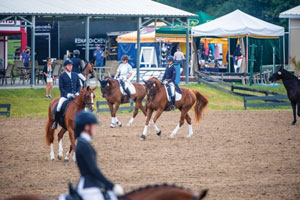
Some riders have lost confidence
in competing after experiencing
bullying tactics in the
warm-up arena.
BULLYING SPECIFIC TO THE EQUINE INDUSTRY
In recent years reports of bullying in the equine industry appear to have risen. It has gotten to such a point that a Facebook page, Stop Bullying In Equestrian Sport, was founded purely to highlight the prevalence of bullying in the industry and to offer riders a place to connect with others who have had negative or traumatic bullying experiences. The page has upwards of 4000 members, and its hashtags, #stopbullyinginequestriansports and #enjoytheride, used by hundred of riders to pledge support and demonstrate their zero-tolerance-for-bullying stance.
From horse trainers speaking out about the culture of bullying and harassment in the racing industry to competitors describing incidences where they were unfairly penalised by the sport’s governing bodies, a common theme in the reporting of such stories is a very real fear of reprisal from ‘higher-ups’ within the industry, and loss of business or licenses.
EA’s Member Protection Policy in fact clearly states that it is against discrimination law to victimise a person who is involved in making a complaint of discrimination or harassment.
The so-called ‘toxic culture’ and bullying that many say is rife within the Australian equestrian scene is not limited solely to the athletes. One of the more recent reports in the media actually involved the EA itself. Equestrian South Australia was recently investigated over allegations made by parents of junior riders being verbally abused by EA staff.
The question is, are incidences of bullying or disputes that require legal intervention more prevalent in the equestrian world than in other sports?
“In general, anywhere you have a hierarchy over those in a weaker or dependant position you will find evidence of those who take advantage. We have represented clients in cases involving jealousy, self-protective attitudes and vendettas across many sporting arenas, not just the equestrian sports. When competitions are judged on even highly educated opinions, the structure of the discipline lends itself to people in authority being in a position to bully or discriminate. Examples of this in equestrian sports can be in the subjective areas of hacking or dressage. Another competitive sport, by way of example, could be ice skating or aerial skiing. Beauty, as they say, is ‘in the eye of the beholder.’
“While clearly not exclusive to the equestrian world, we have certainly been cognisant as to cyberbullying activity within the sport. People must be made aware that it is a criminal act to use the Internet (including social media), to bully.”
“This issue is rapidly growing in legal significance, and the Senate recently received a report on the level of adequacy of existing offences to capture cyberbullying. Jealousy and personal vendettas are as common in the equestrian world as anywhere else and can be very damaging to a person’s reputation and opportunities to advance in the sport. There is an economic penalty as well, where horses that advance also increase in value. This can be big business, where getting selection or having access to opportunity or training is very valuable. I think it is a matter of time before we are presented with such a matter, especially if there is a defined economic loss attributable to such accusations.”
“Unfortunately, there are many instances of bullying that are very subtle or hard to flag to others, and this is where the equestrian industry needs to become more vigilant. Examples include situations where the same people hold multiple positions of office in equestrian organisations for long periods.
“Their power for such things as selection for teams, or training camps, or competitions has the potential to become political and those on the outer may be excluded regardless of performance records. Anyone deemed to go against the status quo or seen as a ‘trouble maker’ or rocking the established boat, may struggle to progress due to entrenched power structures.
“Senior officials and riders may be very guarded about their positions and see new or younger competitors coming up the ranks as a threat to their position and may be quick to condemn or gossip to the detriment of that person. Rumour, in what is a relatively small community, may quickly wound or defame someone on the outer. Reputations may precede riders and horses, to the benefit of some, or disadvantage of others, colouring results of a competitor deemed to be somehow not acceptable to those running a competition, judging, selecting, etc. A more senior judge might influence the marks of more junior judges if they express a dislike or disapproval of a given horse or rider.”
“Not all actions that have a negative impact on a person constitute bullying though. Simply receiving a deserved poor score in an equestrian competition, for instance, is not bullying. If you feel unfairly targeted however, and especially if someone is repeatedly misusing their power over you, this is likely to constitute bullying, and if other satisfactory avenues are not open to you to solve the problem, you are advised to seek legal assistance,”cautions Ross.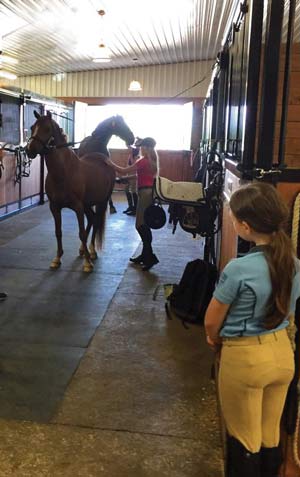
Children should be taught how to deal with bullying as it can cause a range of negative emotions... guilt, isolation, fear, shame, stress and hopelessness
to name but a few.
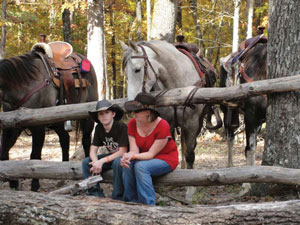
STOPPING BULLIES
Bullying may cause victims to experience a range of negative emotions (in addition to the obvious physical injuries associated with violent behaviours). Feelings of guilt, isolation, fear, shame, stress and hopelessness are to name but a few. No person should have their human rights violated, so what can one do if they find themselves being bullied? “The way to deal with work bullies is to unite with your co-workers. Grouping against a bully will provide victims with support for their feelings, since victims of bullies are at risk of becoming isolated,” advises Dr Mary Lamia, an American-based Clinical Psychologist, author and professor at the Wright Institute in Berkeley in an article written for The Guardian. She comments that workplace bullies tend to try and control or intimidate those with status below or equivalent to themselves. “People wrongly assume bullies have low self-esteem, but their behaviour is actually a response to internalised shame. Although some people who live with shame have low self-esteem, those who behave like bullies tend to have high self-esteem and hubristic pride. They attack others to take away their shame – which allows them to remain unaware of their feelings,” she writes.
EA advises competitors to be mindful of their language, tone of voice and body language. “Address the problem not the person. Let people know that when they are difficult it is their behaviour that is ‘not OK’.”
If bullying occurs in the workplace, then there are remedies available through the Fair Work Commission, including an order to stop bullying, advises Ross Koffel. “Employers must be aware of their responsibility to provide a safe workplace, and it is not good enough to ignore the bullying tactics of say, one employee to another for example, so this is of concern to not just the perpetrator. If the bullying is occurring elsewhere, such as during competitions, then criminal charges are a potential remedy if: you are being threatened; your possessions are affected; or physical violence is involved. Apprehended personal violence orders are available if you feel intimidated for example, by a fellow competitor. There is also anti-discrimination legislation which can become relevant if you are being harassed because of your race, gender identity, sexual preference, HIV/AIDS status, or disability. If the bullying constitutes sexual assault, there are criminal laws to address this. In the equine industry, staff or students can be vulnerable to bullying and/or sexual assault in situations where they are: under the influence of someone deemed to be in power; travel long distances with their employers in the industry; or isolated on properties.”
SUMMARY
“There is probably a ‘status quo’ mentality in equestrian sports, where people are more likely to be expected to be ‘tough’ and just ‘suck it up’ when situations are difficult or demanding…perceived weakness may be derided,” says Ross, before adding that the world of equestrianism is quite a world of its own and is more likely to turn its back on participants if they fall out with the wrong people. “The old guard needs to be aware that historical standards of behaviour are changing and are no longer acceptable to society as a whole. In a changing world, victims are standing up for their rights and society is becoming increasingly sympathetic to their plights. The times are changing, and all sporting fields need to embrace it. ‘Me too’ means ‘you too’!”
USEFUL LINKS:
Pony Club Australia Member Protection Policy www.ponyclubaustralia.com.au/Resources/Policies.aspx
Equestrian Australia Member Protection Policy https://www.equestrian.org.au/policies
Koffels Solicitors & Barristers www.koffels.com.au
Kids Helpline https://www.kidshelp.com.au or 1800 551 800
Lifeline https://www.lifeline.org.au or 13 11 14
The National Centre Against Bullying https://www.ncab.org.au
Professor Mary Lamia www.marylamia.com
UCLA Newsroom www.newsroom.ucla.edu
|